Superb Picasso Paintings
Masters Reproductions
This Picasso Paintings Page is part of 'The Great Masters' section, if you haven't yet read it, or our 'Home Page', maybe you'd like to check them out before reading on.
The following, is a brief biography of Pablo Picasso, his life and works, with several examples of the more famous Picasso paintings woven into the text. If you have a favorite work of his, just let us know the name of the piece, and we'll create it for you from our vast photo stock of his works.
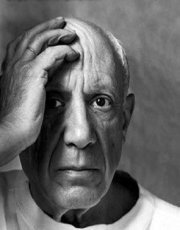 Pablo Picasso was born the son of an art teacher, on October 25, 1881 in Malaga, Spain. He was accepted into the Barcelona School of Fine Arts at the age of 14, and according to local legend, his father, recognizing the enormous talents of his son, gave him his own brushes and palette and vowed never to paint again.
Pablo Picasso was born the son of an art teacher, on October 25, 1881 in Malaga, Spain. He was accepted into the Barcelona School of Fine Arts at the age of 14, and according to local legend, his father, recognizing the enormous talents of his son, gave him his own brushes and palette and vowed never to paint again.
During his lifetime, the artist went through different periods of characteristic painting styles.
The Blue Period of Picasso paintings encompassed the years 1900 through to 1904, and is characterized by the use of different shades of blue underlining the melancholic style of his subjects, mainly people from the grimmer side of life with thin, emaciated bodies.
During Picasso's Rose Period from about 1905 to 1906, his style moved away from the Blue Period to a more friendly pink tone, with subjects taken in large from the circus environment.
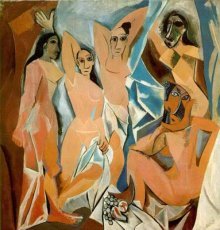 After several trips to Paris, Picasso moved there permanently in 1904. There he met many other famous artists like Henri Matisse, Joan Miro and George Braques.
After several trips to Paris, Picasso moved there permanently in 1904. There he met many other famous artists like Henri Matisse, Joan Miro and George Braques.
He became a great admirer of Henri Matisse and developed a life-long friendship with the master of French Fauvism.
Greatly inspired by the works of Paul Cezanne, he then together with, George Braque and Juan Gris, developed the Cubist style. In Cubism, subjects are reduced to basic geometrical shapes.
In a later version of Cubism, called synthetic cubism, the artists use several views of an object or a person to from different perspectives all in one painting.
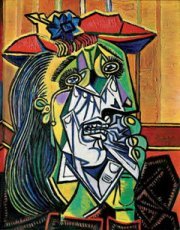 1937 produced the landmark Picasso painting, Guernica, a protest against the barbaric air raid against a Basque village during the Spanish Civil War.
1937 produced the landmark Picasso painting, Guernica, a protest against the barbaric air raid against a Basque village during the Spanish Civil War.
Picasso's painting Guernica is a huge mural on canvas in black, white and grey which was created for the Spanish Pavilion of the Paris World's Fair in 1937.
In Guernica, Picasso used symbolic forms - that are repeatedly found in his works following Guernica - like a dying horse or a weeping woman.
(Pic to your right)
During his life, Picasso changed his companions as often as his painting styles.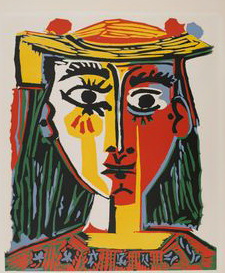
His relationships with women influenced his mood as well as his style of art. His move from the "blue" to the "rose period" could have been the result of meeting Fernande Olivier, his first companion.
During his early years in Paris, he lived with Fernande Olivier for seven years.
Then during World War I, Picasso worked in Rome where he met his first wife, Olga Koklova, a Russian Ballerina.
In 1927 he met Marie Therese Walther, a seventeen year old girl and began an affair with her.
In 1936 another woman, Dora Maar, a photographer, came into his life.
In 1943 he met a young female painter called Francoise Gilot. She gave birth to his third and fourth children.
The artists last companion was Jacqueline Roque. He met her in 1953 and married her in 1961.
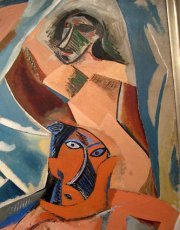
In 1965, Picasso had to undergo a prostrate operation. Then after a brief sabbatical, he focussed his attentions on drawings and a series of 347 etchings.
In spite of his health problems, he created a number of paintings during his last years.
Then on April 8, 1973 Pablo Picasso died of old age at 91.
Famous Picasso quote:
"I think about Death all the time. She is the only woman who never leaves me." Return to 'Meet The Masters'
'Return From Picasso Paintings To Family And Pet Portraits Home Page'